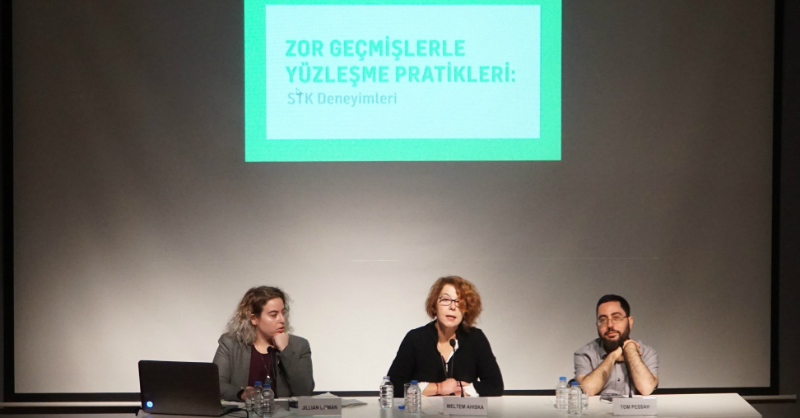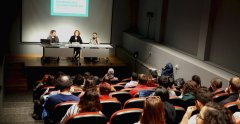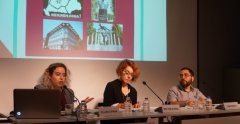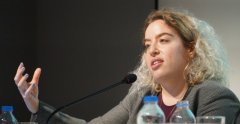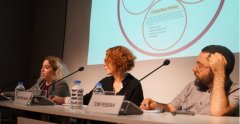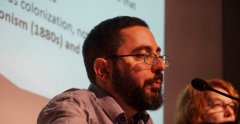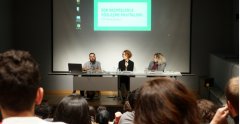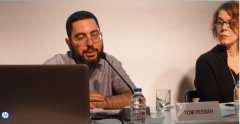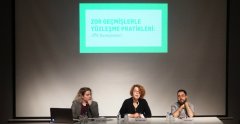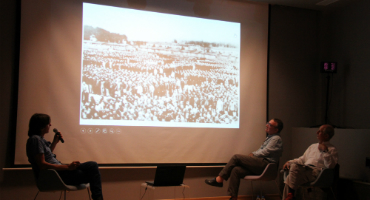Jillian Lipman from Zachor Foundation for Social Remembrance which operates in Hungary and whose mission is to implement programs on Holocaust education and to raise the awareness of educators and students of diverse backgrounds on issues like Jewish tradition and culture, anti-Semitism, racism, prejudice; and Tom Pessah from Zochrot which is an NGO based in Israel and which runs projects dedicated to promoting acknowledgement and accountability for the ongoing injustices of the Nakba, to raising awareness for the right to return of the Palestinians to Israel, and the reconceptualization of the Return as the imperative redress of the Nakba, presented the work of their organizations. The panel was moderated by Meltem Ahıska.
Jillian Lipman explained that Zachor works against xenophobia in all forms, teaching about Holocaust remembrance and putting it into a context of today as a way to empower young people. Zachor as a partner of USC Shoah Foundation provides access to the visual history archive of the Shoah Foundation which consists of over 55.000 testimonies of the survivors of Holocaust, Rwanda, Guatamela genocides. Zachor also benefits from the IWitness Platform for educators and students and exercise activities with students and teachers.
Lipman stressed that the testimonies are important and mentioned that when students think about Holocaust the first thing that comes to their mind is usually Auschwitz whereas they don’t imagine what happened in house next door. Lipman explained that Zachor includes students to their work which allows the students to exercise critical thinking. According to Lipman, testimonies and accounts provide a face to the past and to the sufferings and it is easier for the students to make a connection with the past through testimonies. Lipman also gave information about their Iwalk program and explained that they organize tours to former Jewish neighborhoods which enables them to make a connection between sites and historical events. Lipman also gave information about how Hungary deals with Holocaust. Lipman mentioned that before 2012 there was no mention about Jews and Romas in the history textbooks and the textbooks only covered Hungarian victims. It was after 2012 that the textbooks started to cover the Holocaust and how Jews and Romas suffered. The 2014 was declared as Holocaust remembrance year.
Tom Pessah, who is one of the board members of Zochrot organization which was founded in 2002 in Tel Aviv, started his presentation by providing the historical background of Nakba and he informed the audience that within the scope of Nakba a total number of 770.000 people from 418 villages in 11 cities were forcibly displaced. Pessah mentioned that ‘key’ is the symbol that the Palestinians use while protesting the forced displacement and he explained that as ‘the key’ is the symbol of the demand for return Zochrot preferred to design their logo as the keyhole. The work of the organization is to address this significant demand through its activities.
Zor Geçmişlerle Yüzleşme Pratikleri: STK Deneyimleri paneli yapıldı
Pessah explained that despite it is unimaginable, for Palestinians return is usually in the agenda whereas for Israelis the ‘right to return’ is never in their agenda.
In his presentation Pessah told that Zochrot implements projects and activities under six programs such as : Space for Return, political education, pre-transitional justice,knowledge and culture, film festival and public outreach, multimedia and internet.
Within the scope of the activities, Pessah explained that Zochrot organizes open tours to destroyed villages and towns, includes the refugees in these tours and informs the participants about the history of these villages; organizes conferences; raises awareness about the destroyed villages by I-Nakba application, organizes film festivals and raises awareness about Nakba and right violations through developing education programs.
Pessah also talked about the challenges like harassments and pressures that they face but also told that repression isn’t all bad as it has the potential to trigger interest and attention.


